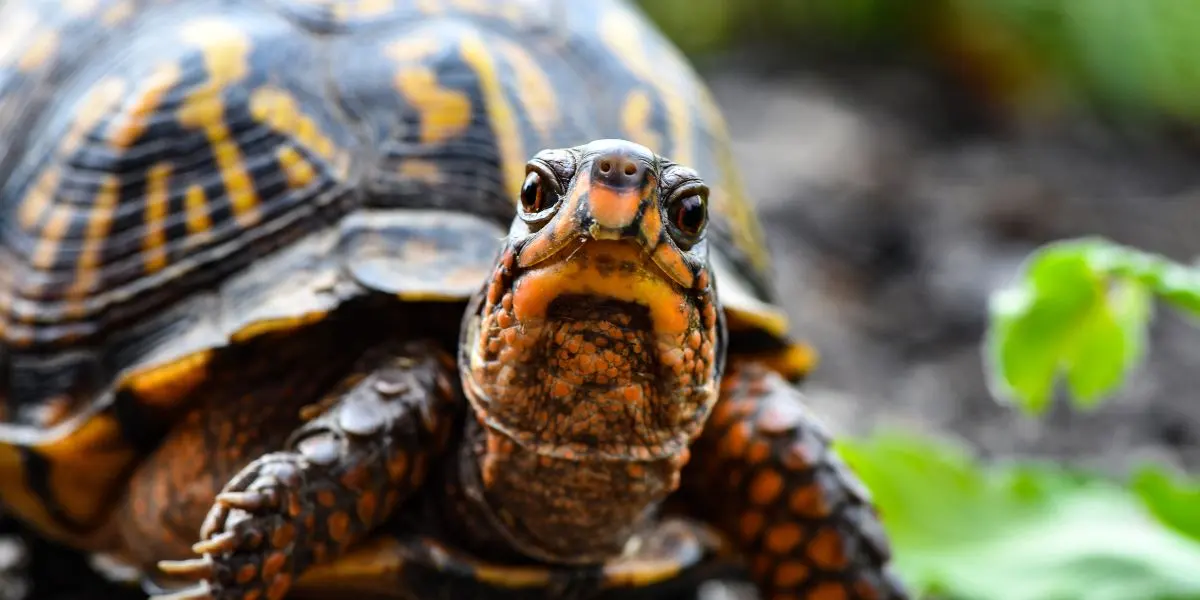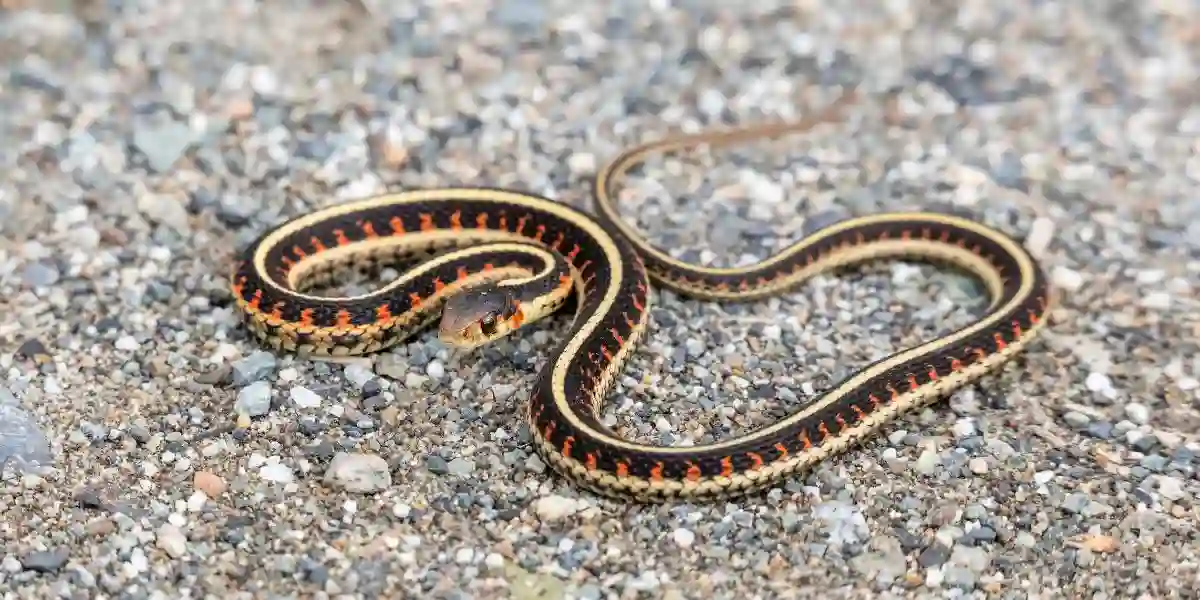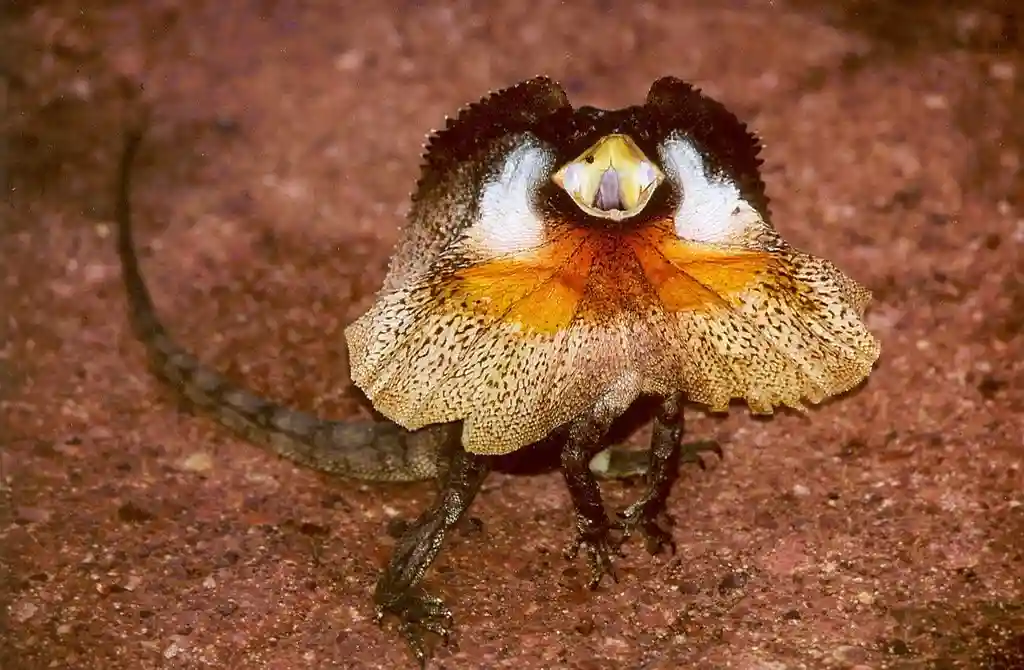Did you know that the African Fat-Tailed Gecko possesses a unique ability to store excess fat in its tail? This captivating reptile, scientifically known as Hemitheconyx caudopunctatus, has many interesting features that make it stand out among other geckos.

In this article, we will explore the physical appearance, habitat and distribution, behavior and lifestyle, reproduction and life cycle, diet, and feeding habits of this remarkable species. Join us on a journey through the fascinating world of the African Fat-Tailed Gecko!
What is The African Fat-Tailed Gecko
The African Fat-Tailed Gecko is a mesmerizing reptile characterized by its unique physical appearance and notable features. Here, we will delve deeper into the details of its size, coloration, and distinctive attributes.
Measuring around 20 centimeters (7.9 inches) in length on average, this medium-sized gecko possesses a stout body covered in rough scales. Its skin coloration can vary from light tan to dark brown, allowing it to blend seamlessly with its natural surroundings. However, what truly sets this species apart is the prominent bumpy patterns that run along its back, giving it an alluring textured appearance.
One of the most striking features of the African Fat-Tailed Gecko is its eyes. Like many geckos, they have vertical pupils, which aid in their nocturnal vision during low-light conditions. Their eye colors can range from golden yellow to reddish-orange hues, depending on individual variations.
But perhaps one of the most remarkable characteristics displayed by these geckos is their wide flat tail. As suggested by their common name, African Fat-Tailed Geckos possess an exceptional ability: storing excess fat reserves within their tails for times when food sources become scarce or during periods of hibernation. The plumpness of their tails acts as a visible indicator of overall health and vitality.
In summary, the African Fat-Tailed Gecko presents a captivating visual display with its rough-scaled body adorned with bumpy patterns and vibrant eyes featuring vertical pupils. However, it’s their unique adaptation in storing fat reserves within their broad tails that truly grabs attention – making them both fascinating and distinct among other gecko species.
Habitat and Distribution
The African Fat-Tailed Gecko is primarily found in the arid regions of West Africa, specifically in countries such as Mali, Guinea-Bissau, and Senegal. This species has adapted to thrive in a variety of habitats within these regions.

These geckos prefer to inhabit savannas and rocky areas where they can find ample opportunities for shelter and suitable microclimates. They have an affinity for dry environments with moderate temperatures. However, it’s important to note that they require access to hiding spots like rocky crevices or burrows during the day to protect themselves from excessive heat or predation.

The natural habitat of the African Fat-Tailed Gecko often consists of granitic outcrops or sandy soils intermixed with vegetation such as grasses or shrubs, where they can hide and blend into their surroundings effectively. These reptiles are known for their exceptional camouflage abilities, allowing them to remain inconspicuous while waiting for prey or avoiding predators.
As far as distribution goes, this species is endemic to specific parts of West Africa but can be found across various countries within that region. The exact range extends from northeastern Guinea through southern Mali and western Niger down to northern Nigeria. Within these territories, these geckos have managed to establish populations despite facing challenges posed by human activities such as deforestation and land-use changes.
Behavior and Lifestyle
The African Fat-Tailed Gecko exhibits fascinating behaviors that contribute to its unique lifestyle. Understanding these aspects allows us to appreciate the remarkable adaptations of this reptilian species.
Nocturnal Nature:
These geckos are nocturnal creatures, meaning they are primarily active during the night and rest during the day. They have specialized adaptations, such as vertical pupils in their eyes, that allow them to navigate effectively in low-light conditions. Their preference for darkness helps them avoid diurnal predators while increasing their chances of locating prey.
Camouflage and Defense:
The African Fat-Tailed Gecko possesses exceptional camouflage abilities, enabling it to blend seamlessly with its surroundings. Its rough scales help break up any shadows or light patterns on its body, making it nearly invisible to potential threats or prey alike. Additionally, when threatened or stressed, these geckos can vocalize by emitting loud chirping sounds as a defense mechanism.

Solitary Nature:
While African Fat-Tailed Geckos do not show aggressive behavior towards conspecifics (members of their same species), they are predominantly solitary creatures outside of mating periods. They prefer maintaining individual territories where they hunt for food and seek out suitable shelter options such as crevices or burrows within rocky habitats.
Feeding Habits:
These geckos are insectivores and possess impressive hunting skills. Using their keen sense of smell, they detect nearby prey items like crickets, mealworms, wax worms, and roaches with remarkable accuracy, even in darkness. Once located, they immobilize their prey with a quick bite before swallowing it whole—an efficient strategy for securing nutrition quickly.
Temperature Regulation:
Being native to arid regions with fluctuating temperatures throughout the day requires unique thermoregulatory adaptations from the African Fat-Tailed Gecko. It can tolerate high temperatures up to 90°F (32°C) by seeking shelter in cooler microhabitats during the day, such as rock crevices or burrows.
Reproduction and Life Cycle
The life cycle of the African Fat-Tailed Gecko involves intriguing reproductive strategies and fascinating behaviors. Let’s explore how these geckos reproduce and ensure the survival of their species.
Mating Rituals:
During the breeding season, male African Fat-Tailed Geckos use various cues to attract females. These cues include tactile interactions such as gentle biting or nudging, along with visual displays such as head bobbing or tail waving. The males compete for a female’s attention by engaging in dominance displays, showcasing their fitness as potential mates.
Egg-laying:
After successful courtship, females lay one or two eggs per clutch. The number of clutches produced each year can vary depending on environmental conditions and individual health. Typically, they find secure locations within their habitat to bury the eggs underground or beneath rocky crevices where the developing embryos are safeguarded from predators.
Incubation Period:
Once laid, it takes approximately 60 days for the African Fat-Tailed Gecko eggs to hatch under suitable environmental temperatures ranging between 85°F to 90°F (29°C to 32°C). Unlike some reptiles that provide parental care during incubation, these geckos do not exhibit any significant involvement beyond egg deposition.
Independent Hatchlings:
Upon hatching, hatchlings possess fully functional bodies and are self-sufficient from birth as miniature replicas of adult geckos. They immediately embark on an independent journey, adapting their behaviors to survive in their arid habitats, just like adults. It is worth noting that sexual maturity is typically reached at around one year of age.
Longevity:
In captivity, with proper care and nutrition, African Fat-Tailed Geckos can live up to twenty years or more—a significant lifespan compared to other reptiles of similar size.
Diet and Feeding
The African Fat-Tailed Gecko has a specific diet and unique feeding behaviors that enable it to meet its dietary needs. Let’s explore the typical food sources for these fascinating reptiles and how they obtain their nourishment.
Insectivorous Diet:
The primary diet of the African Fat-Tailed Gecko consists of various small invertebrates, primarily insects. They are avid insectivores, consuming a range of prey items, including crickets, mealworms, wax worms, roaches, and other small arthropods found within their natural habitat.
Hunting Strategy:
These geckos exhibit impressive hunting skills despite being relatively sedentary creatures. They employ a sit-and-wait hunting strategy by remaining motionless near areas where insects are likely to pass by or gather, such as around rock formations or under vegetation.
Keen Sense of Smell:
African Fat-Tailed Geckos rely heavily on their acute sense of smell to locate prey in dim lighting conditions during nighttime hours. They can detect the scent trails left behind by potential food sources with remarkable accuracy.
Swallowing Prey Whole:
Once an unsuspecting creature crosses into striking distance, the gecko will lunge at its target with precision and bite down quickly with sharp teeth to immobilize it before swallowing it whole. This efficient feeding behavior ensures that they receive adequate nutrition without wasting energy on unnecessary movement or chewing.
Supplementation Requirements:
In captivity, providing a varied diet is essential for maintaining proper nutrition for these geckos’ overall well-being. Dusting their food items with calcium powder helps ensure they receive the necessary calcium supplementation for healthy bone development.
It’s important to replicate their natural feeding habits while in captivity by offering live prey such as appropriately sized gut-loaded (nutrient-rich) crickets or mealworms regularly to promote an active and healthy lifestyle.
Conservation Status
As of now, the African Fat-Tailed Gecko is listed as being of “Least Concern” on the IUCN Red List. However, there are certain conservation considerations and potential threats that need to be addressed for the long-term survival of this species within their natural habitat.
Habitat Loss:
The conversion of land for agricultural purposes and urban development poses a significant threat to the African Fat-Tailed Gecko’s native habitats. Deforestation and changes in land use result in a loss or fragmentation of suitable environments, impacting populations by limiting their access to resources and reducing available space for breeding and foraging.
Collection for Exotic Pet Trade:
These geckos have gained popularity within the exotic pet trade due to their captivating appearance and ease of care in captivity. While legally protected in some countries, such as Guinea-Bissau, unregulated collection activities can still occur elsewhere, leading to unsustainable practices if not carefully monitored.
Climate Change:
As arid-adapted reptiles, African Fat-Tailed Geckos rely on predictable temperature patterns and specific climatic conditions within their habitats. Climate change has the potential to disrupt these crucial factors affecting their survival through alterations in rainfall patterns, heatwaves, or extreme temperatures.
Efforts towards implementing sustainable conservation measures should include:
- Habitat Protection: Establishing protected areas or wildlife reserves that encompass critical habitats will safeguard these geckos from further degradation and provide refuge for sustaining population numbers.
- Regulated Trade: Enforcing regulations surrounding legal trade while promoting responsible ownership practices can help prevent the overexploitation of wild populations.
- Public Education: Informing communities living near gecko habitats about the importance of conservation will foster an appreciation for these reptiles while encouraging local participation in protecting them.
- Scientific Research: Further studies on population dynamics, genetic diversity, and ecological requirements will aid in understanding the specific conservation needs of the African Fat-Tailed Gecko.
Fun Facts
| Feature | |
|---|---|
| Tail Fat Storage | Wide and flat tail that stores excess fat reserves, enabling survival during periods of food scarcity or hibernation. |
| Chirping Communication | Ability to emit chirping sounds when threatened or agitated, setting them apart from other gecko species and allowing auditory communication. |
| Color Morphs and Patterns | Exhibit various color morphs, ranging from tan to brown, and have pattern variations such as stripes or spots. |
| Nocturnal Hunters | Adaptations for hunting in low-light conditions, including vertical pupils, specialized retinas, and ultra-sensitive rod cells for enhanced night vision. |
| Long Lifespan | Capable of living up to twenty years or more with proper care and nutrition in captivity, surpassing the lifespan of other reptiles of similar size. |
| Tolerant Temperature Range | Ability to tolerate temperature ranges between 85°F to 90°F (29°C to 32°C), seeking sheltered spots for heat regulation during extreme weather conditions in their native arid habitats. |
| Masters of Camouflage | Rough-scaled bodies with bumpy patterns that resemble the texture found in their natural habitats, allowing them to blend seamlessly into their surroundings as a defense mechanism against predators. |
| Keen Adaptations | Unique adaptations to survive in arid environments, including obtaining hydration from food sources and reducing evaporative water loss through specialized skin scales. |
Frequently Asked Questions
African fat-tailed geckos are generally considered to be relatively easy to take care of compared to some other reptile species. They have similar care requirements to leopard geckos, making them a popular choice for reptile enthusiasts. However, it’s important to provide them with a suitable habitat and proper husbandry to ensure their well-being.
For a single African fat-tailed gecko, a 20-gallon tank is usually recommended as a minimum size. However, larger enclosures, such as 30-40 gallons, are even better to allow for more space and enrichment. Providing hiding spots, branches, and other structures for climbing is important to create a stimulating environment for the gecko.
African fat-tailed geckos and leopard geckos share some similarities, such as their appearance and general care requirements. However, they are different species with distinct characteristics. African fat-tailed geckos have a thicker tail and are known for their calm and docile nature compared to leopard geckos.
Some African fat-tailed geckos can tolerate being held, but it ultimately depends on the individual gecko’s temperament. While they may not seek out human interaction like dogs or cats, regular gentle handling from a young age can help them become more accustomed to being held. It’s important to handle them with care and respect their boundaries.
African fat-tailed geckos require a heat source to maintain the proper temperature gradient in their enclosure. While some keepers use heat lamps, it’s generally recommended to use an under-tank heating pad or heat tape to provide belly heat. This mimics the natural heating from the ground and allows the geckos to regulate their body temperature effectively.
The number of crickets to feed an African fat-tailed gecko depends on its age, size, and individual appetite. As a general guideline, juvenile geckos can be fed 3-5 appropriately sized crickets per feeding, while adults may eat 2-3 crickets. It’s essential to monitor their weight and adjust the feeding amounts accordingly to prevent overfeeding or obesity.
Juvenile African fat-tailed geckos should be fed daily, while adults can be fed every other day or every two days. It’s important to provide them with appropriately sized and gut-loaded insects, such as crickets or mealworms. The feeding frequency can be adjusted based on the gecko’s age, size, and individual needs.
While insects form the primary diet of African fat-tailed geckos, they can also consume small amounts of fruit occasionally. However, fruits should not be a significant part of their diet and should be offered sparingly as a treat. It’s essential to choose fruits that are safe for geckos, such as mashed bananas or small pieces of mango or papaya, and remove any uneaten fruit to prevent spoilage.
African fat-tailed geckos have an average lifespan of around 10-15 years, although, with proper care, they can live even longer. Factors such as genetics, diet, habitat conditions, and overall health contribute to their lifespan. Providing appropriate housing, nutrition, and regular veterinary check-ups can help ensure a long and healthy life for African fat-tailed geckos.
Conclusion
Throughout this exploration of the African Fat-Tailed Gecko, we have uncovered a captivating reptile with remarkable features and behaviors that set it apart from other gecko species. From its distinctive physical appearance, including the wide flat tail for storing fat reserves, to its fascinating hunting techniques and unique vocalizations, the African Fat-Tailed Gecko offers a wealth of intrigue.
This reptile’s natural habitat in the arid regions of West Africa provides an environment where they can thrive. However, their survival is not without challenges. Habitat loss due to human activities and potential over-collection for the exotic pet trade pose threats that need to be addressed through conservation efforts.
Understanding the life cycle and reproductive strategies of these geckos highlights their resilience as they adapt to survive in their dynamic environments. Their nocturnal nature, efficient hunting skills, and ability to camouflage make them intriguing creatures that continue to captivate researchers and enthusiasts alike.
As custodians of our planet’s biodiversity, we must appreciate and protect these remarkable creatures. By promoting habitat preservation, responsible trade practices, public education initiatives about their value in ecosystems, and continued scientific research on their behavior and biology—we can contribute towards ensuring a bright future for the African Fat-Tailed Gecko.
Let us celebrate these charismatic reptiles by admiring their unique traits while actively working together towards safeguarding their habitats so future generations can appreciate these wonderous creatures just as much as we do today.




